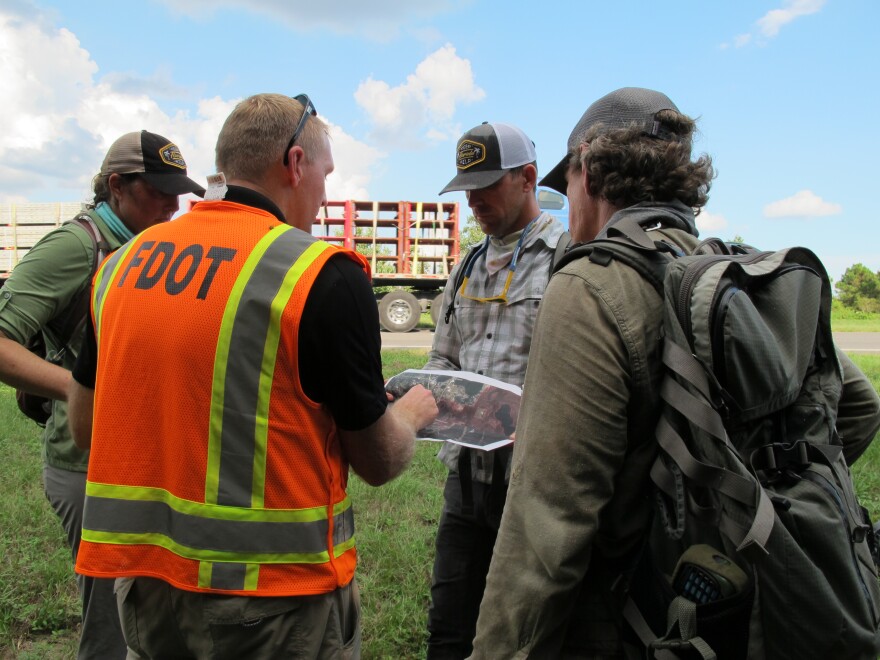Members of the Florida Wildlife Corridor Expedition crossed busy U.S. Highway 27 in southern Polk County Tuesday. It's the midpoint in their weeklong journey to keep a natural wildlife corridor connected into the future.
The three conservationists - Mallory Lykes Dimmitt, Joe Guthrie and Carlton Ward Jr. - crossed near an underground culvert that is used by smaller wildlife to go under U.S. 27. It's the site of a proposed underpass that could be built when the highway is widened to six lanes.
Guthrie, a bear biologist, described the crossing as a "non-descript place." He remembers it well, though. When he was a graduate student working at Archbold Biological Station in Highlands County, he said he would always remember a wetland on the east side of the highway.
"It was like, it's a wetland, it's not a strip mall," he said. "Little did I know then that I would be standing on the side of the highway here as this anchor point for this really, really vital, small connector in this much larger corridor.
"If this winks out," he said, "there is no reasonable expectation of having any wildlife corridor crossing between here and Orlando, at I-4," Guthrie said. "Between here and Lake Placid, there's only one place that's reasonable, along Josephine Creek. You don't have much left."
Ward said the development crowding out much of U.S. 27 farther north in Polk County could soon happen here, too.
"That is like a time machine not too many years into the future for the type of pressures that are targeting these landscapes," he said. "And up there, you could almost see the orange groves timbering to rooftops. And that sort of development energy is coming to most or all of Florida.
"And so it really raises the stakes - hopefully raises the inspiration - for these last connections that we're able to traverse here," he said.
Brent Setchell, district drainage design engineer for the Florida Department of Transportation District 1 in Bartow, says a wildlife crossing feasibility report would be done before the road is widened. That includes seeing if the location is appropriate and what targeted species would use it, what kind of roadkill has been found there, as well as doing a cost analysis.
If the study calls for an underpass, they'll consider using or widening the existing box culvert under the road.

For an overpass, the state would have to acquire right-of-way from the land owners. He says besides underpasses built on Interstate 4 near Daytona Beach and on Alligator Alley, there are only a few that have been built in Florida.
"I think it's just a new thing," Setchell said. "Florida's relatively flat. In other states, the road is cut into the side of a hill, so the wildlife crossing is more or less a straight shot across. Versus in Florida, the wildlife would have to go up and over the crossing. It's something that we're looking into more and more, as we look to optimize and make these crossings more and more cost-effective and efficient, and that they're used by the targeted species."
Before the group crossed the highway, Guthrie told Setchell underpasses don't work very well unless there's fencing that funnels wildlife into them.

Setchell said that would work, but there would have to be gates or openings to allow for nearby landowners to reach their property.
Setchell credited groups like the Florida Wildlife Corridor for getting that awareness of the need for crossings to transportation planners.
"DOT does a good job when we know there's a need," he said. "As long as we know early enough, we can plan for that and get it into a project. The problem is when it comes in last-minute, then it's like where's the money going to come from to add that feature... we don't have time scheduled to buy that right-of-way for it. So if we know early enough, we can certainly plan for that and incorporate it into our project."
Back at the U.S. 27 crossing, Dimmitt said because much of the corridor here is fragmented, they have to pick their way through to create a continuous path to travel.
"Picking the place to cross any highway for these expeditions, as we've done them over time, are really challenging," she said. "Because we're trying to find places where the habitat connects up on either side, where there's protected land that's going to stay that way into the future that we know is going to be a viable wildlife corridor.
"And so on the east side of the road here, there's a large swath of conservation land," Dimmitt said. "But it's challenging on the west side of the Ridge, there are more isolated pockets of conservation, but not that connected corridor that we would like to see."
The expeditioners took off on horseback Sunday from Highlands Hammock State Park near Sebring. They started on horseback, in part, as an homage to the private ranchlands that make up a significant part of the wildlife corridor.
"We've been through some incredibly beautiful private lands from Highlands Hammock State Park and where we came through today," Dimmitt said as they prepared to cross U.S. 27, "and then on this side, on the west side of 27 before we cross over, through Saddle Blanket Scrub Preserve of The Nature Conservancy, which was a conservation property and kind of a cornerstone property before we headed east.''
On Thursday through Saturday, they'll traverse the Lake Wales Ridge State Forest, Avon Park Air Force Range and arrive at The Nature Conservancy's Tiger Creek Preserve. There will be a finale Saturday, Oct. 26, at Bok Tower Gardens in Lake Wales.












